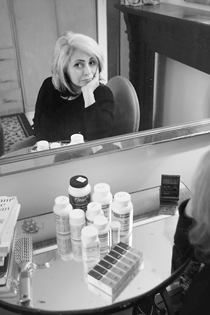Performer Penny Arcade goes public about living with hepatitis C
Penny Arcade is accustomed to being noticed. The 55-year-old performance artist has been a poster child for the East Village avant-garde art scene since Andy Warhol roamed the city. In recent years, she’s become a vocal proponent for artists struggling to remain residents of the increasingly gentrified neighborhood. So when she was diagnosed with the hepatitis C virus two-and-a-half years ago, it was only natural that she would slip into the role of unofficial spokeswoman for sufferers of a disease that often strikes people living on the margins.
Arcade was diagnosed the blood-borne disease that attacks the liver in the spring of 2003. Less than a year later, her 57-year-old brother-in-law, Guy Gouin, died of HCV. While Gouin lay dying, Arcade scoured literature about the disease they shared as part of a quest to conquer her own illness.
“When you’re confronted with having an illness, you enter into a maze and it’s up to you to make a decision,” she said this week in a telephone interview. “We have to take responsibility for our own treatment. I had to really become an expert on hepatitis C to find out what was the most appropriate thing for me.”
A chronic disease, HCV has widely disparate effects on different people. According to the city’s health department, 10 percent of people clear the virus from their system after contracting it, but 80 to 90 percent become chronic carriers. Anywhere between five and 20 percent of carriers will develop cirrhosis of the liver. Of those with cirrhosis, between one and three percent will develop liver cancer.
HVC has infected a large swath of the American population. About four million Americans have been infected with the virus and 2.7 million are carriers, 8,000 to 10,000 of whom will die this year from complications. That number is expected to balloon to 30,000 per year by 2015.
A small virus that lives in blood, HCV is quite easy to contract and far more prevalent than HIV, the virus that causes AIDS. HCV rates, however, are much higher among people living with HIV than in the general population. In New York City alone, between 200,000 and 300,000 people are infected with HCV, compared with about 90,000 New Yorkers with HIV in 2003, according to the health department.
People who have injected drugs and those who had blood transfusions before 1992, when blood-screening tests improved, are most at risk. But anyone in contact with infected blood, including healthcare workers and infants born to infected mothers, is at risk. Sexual transmission, while considered rare, has not been ruled out as a risk factor.
Since most people don’t develop symptoms or serious liver damage for decades—and some never do at all—few know they carry a contagious disease that might ravage their liver.
“Even though it’s set to be a pandemic in this country, very few people know about it,” said Arcade.
In August, from the stage at Joe’s Pub on Lafayette Street where she performed “The Essential Penny Arcade” as part of the East Village HOWL! Festival, Arcade told her audience she had HCV.
“I want to make people aware,” she said in this week’s interview. “There’s a lot of stigma to illness in this country… I spent a lot of time with people with AIDS and I know how people treat people with contagious diseases.”
Ironically, Allen Ginsberg, author of the poem “Howl” for which the festival was founded, died of complications from HCV. He is not the only ‘60s icon struck by the disease. Phil Lesh of the Grateful Dead received a liver transplant several years ago, as did David Crosby of Crosby, Stills, and Nash; both suffer from HCV. Ken Kesey, author of “One Flew Over the Cuckoo’s Nest” and famous for his drug experimentation with the Merry Pranksters (out of which the Grateful dead formed and chronicled by Tom Wolfe in “The Electric Kool-Aid Acid Test”) died of liver cancer in 2001, after suffering for years from HCV.
Arcade is not sure how she contracted the illness. During her youth in the East Village, she was part of Andy Warhol’s Factory scene, appearing in the 1971 film “Andy Warhol’s Women in Revolt. She also participated in the “the Lower Eastside drug culture of the late 60’s” when she was 17, she wrote in an e-mail follow-up to her interview.
But Arcade also wonders if she might have contracted it during the four years she lived in Spain in the 1970s or while traveling in Thailand, India, and Indonesia in the 1990s. She believes her brother-in-law contracted HCV while serving in Vietnam. A 2002 survey of 597 homeless veterans found that 42 percent were infected with the virus, according to New York’s health department.
Stigma might be part of the reason why HCV is so rarely discussed in the public arena.
“Once there’s a certain level of stigma, it becomes harder to give people accurate information about a disease and that can be really problematic,” said Tracy Swan, co-infection project director for HIV and HCV at the Treatment Action Group, an AIDS advocacy group located at Houston Street and Broadway. “There’s something about human nature where people really wonder: how’d you get that?”
Miles Keaton Andrew, a 52-year-old author who contracted HCV when he experimented with intravenous drugs as a teenager, has kept a blog, mkandrew.com, since 2001 about his experiences battling the virus. His blog has received a million hits in the past year.
“I understand the whole stigma thing,” he said. “There are a lot of people like me who might have experimented with drugs. Some of us got sick from it and it isn’t anything to be ashamed about.”
This week, Arcade began a 24-week-long treatment program in the hopes of curing herself. Already, she is sharing her experience with those in her community. In an Oct. 2 e-mail to the listserv maintained by the Federation of East Village Artists, an organization founded to support the local arts community, Arcade wrote, “I start [treatment] tomorrow and I have no idea how I will feel, as each person is different. Although my understanding is that you feel worse when the drugs build up in your system.”
A few days later, she wrote the group, “Tonight’s [FEVA] meeting is supposed to be about health insurance. I am not attending as I have started serious medicine for hepatitis C and do not feel well enough to go out.”
Arcade plans to keep a diary of her treatment, which can cause extreme flu-like symptoms that Arcade compared to those from chemotherapy. “I want to write about it,” she said.
Arcade suffers from a strain of HCV that is less common in the United States and more easily treatable, she said, adding that people with her strain have an 88 percent cure rate after treatment. The typical treatment for most American strains ranges from a three-month to a two-year drug therapy program. Treatment does not eradicate the virus in all cases. Some people, however, do not need drug therapy at all.
“Before you go on Interferon”—a drug commonly used to treat HCV—“you try to imagine the sickest you’ve ever been and you figure you’ll be that sick, but the truth is you can’t imagine how sick you’ll be,” said Andrew. “For a year it completely consumes your life.”
Arcade has lived in the East Village since the beginning of the AIDS crisis—she moved there when she was 17—and remembers a time when there was little information about the disease that ravaged her community. “A lot of us thought we were going to get it [AIDS] and we didn’t get it,” she said. “Ten years later to find out that you have a potentially fatal disease is a huge shock.”
Arcade’s self-anointed emergence as East Village HCV spokeswoman coincided with the July launch of an ad campaign by Hoffman La Roche, a pharmaceutical company. The campaign—plastered throughout the city’s subways, in magazines and in newspapers—depicts a man’s face, severely beaten and bruised. The text reads: “If Hep. C was attacking your face instead of your liver, you’d do something about it. Ready to fight back?”
The startling image of a brutalized face has not received a warm welcome from the HCV healthcare community.
“It’s rude and cruel and horrible and stupid,” said Dr. David Ores, a general practitioner on Clinton Street on the Lower East Side. Several of his patients suffer from the virus.
“What if you don’t have insurance?” Ores asked. “What if you have no access to care? You can’t even get tested. Whoever put up those posters, are they offering free healthcare?”
“It’s extremely alarming, from a purely feminist perspective; could you imagine that ad with a woman who’d been beaten black and blue?” said Swan, adding that not all people living with HCV need treatment or develop serious liver damage. “If you had hep C and you saw that, wouldn’t you think ‘Oh my God?’ ”
The ad was intended to alarm, said Bob Madison, a spokesman for Hoffman La Roche. “We really wanted to break through the clutter and do something to separate us from the noise; that’s why it’s such a distinctive campaign,” he said, acknowledging that some response has been negative. “This is a very dramatic call to action.”
Arcade has a publicity campaign of her own in the works. She is currently working with the Lower East Side Biography Project, a media-training program, on a series of public service announcements she hopes will run on cable TV in the spring. For those working in the healthcare industry, Arcade’s decision to go public comes as a welcome voice in a silent arena.
“It’s extremely useful and it’s great that she’s doing this,” said Swan. “Like with the HIV activist model, it’s important to have people in the community sharing information about their experience.”
gaycitynews.com

































